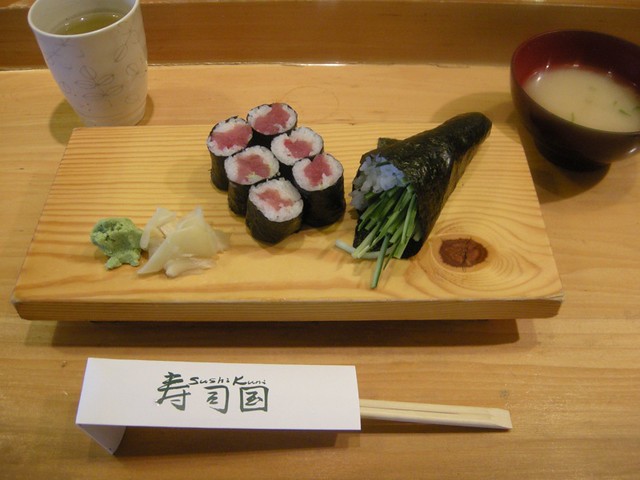
Do you guys all know my pops? His name is Kunio, and he is a sushi chef. Classically trained as a tempura chef, he was offered to transfer to Los Angeles where Inagiku, the Tokyo restaurant he worked at, was opening a location in the iconic
Bonaventure Hotel. So, the Akaboris all ended up in sunny LA in 1980.
Kuni has a sparkling sense of humor, but you wouldn't really think so if you saw him working at Sushi Kuni, his restaurant in Cupertino, CA. Handling raw fish is a sensitive matter, so he is all concentration, all the time.
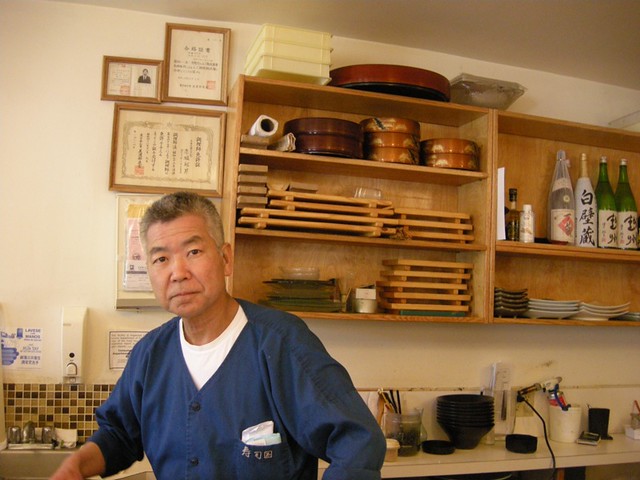 Kuni hates being photographed.
Kuni hates being photographed.
Kuni is a painter, and his artful mind comes out in his dishes. He loves to play with the colors of the ingredients, shapes and techniques. He is a great chef who is passionate about his work.
Today, let's talk about
makimono, which literally translated to "wrapped things". In the world of sushi, we are talking about rice and condiments wrapped in crispy
nori (seaweed). But in the overly-indulgent Western world of Spider, Rainbow and (Insert Local Sports Team Name) rolls, the real-deal
makimono get no love. So let's get back to basics and highlight some of the
makimono that you would actually be able to order at a sushi counter in Tsukiji market.
Hosomaki vs. Temaki

Hosomaki is
hoso = thin;
maki = roll. It is usually cut into six pieces and are little bite-size portions.
Temaki is
te = hand;
maki = roll. Hence, the handroll. It is not cut up into pieces, and you just eat it... in hand. Temaki parties are also
very easy and fun.
Tekka Maki
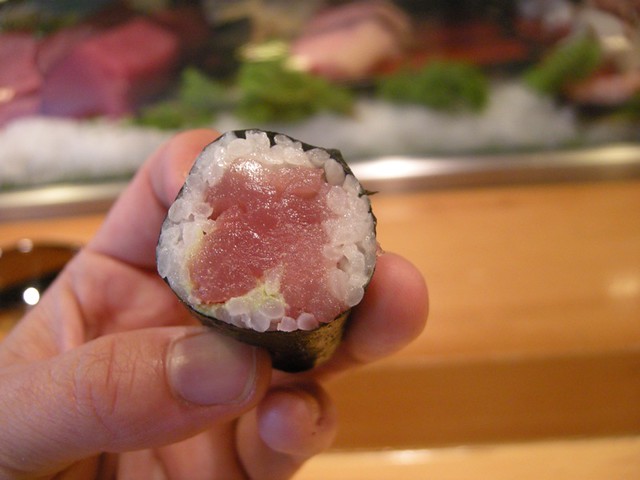
This roll is one of the most basic of the
makimono. Fresh, raw tuna with rice and a dab of wasabi, wrapped in
nori. Kuni tells me that this is roll was names after the
tekka-ba, which was the name of the gambling halls back in the 1800s. According to Kuni, the invention of the tekka-maki came from when they served these little juicy finger food while the men were gambling. They are easy to eat, and so damn good. He believes that the tekka-maki was one of the very first
makimono, preceded by the
kanpyo maki (seasoned dried gourd), since they could be preserved for longer.
Kappa Maki
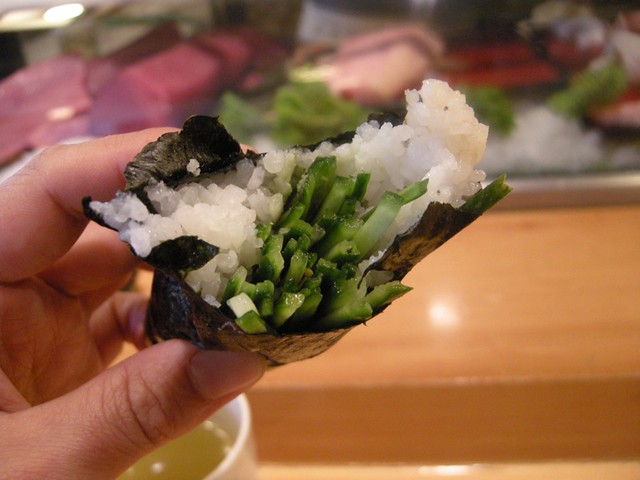
Kappa maki is simply a fresh julienned cucumber roll. It is named after the mythical Japanese turtle-frog creature,
kappa, who like to eat cucumbers.
Futomaki
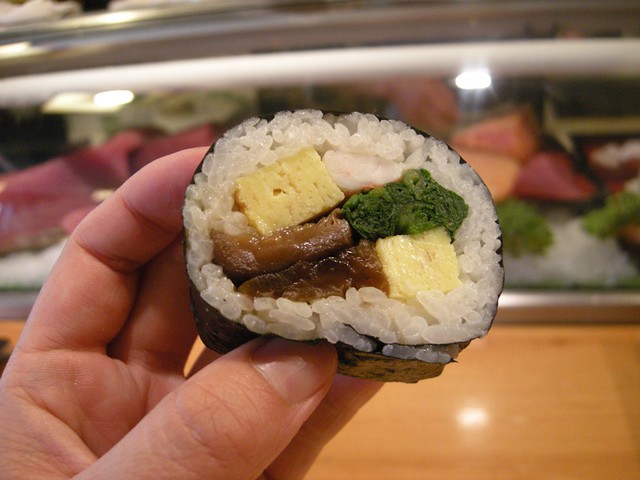 Futo-i
Futo-i means "fat" so this is literally a "fat roll". Different chefs have their own way of making them, but generally it will contain boiled spinach,
kanpyo (seasoned dried gourd) and
tamago-yaki (fried egg). Kuni also adds seasoned
shiitake mushrooms and some
ebi (shrimp).
Kanpyo on its own is a
makimono classic, but I always end up getting Kuni's futomaki for all the additional ingredients.
Shiokara Temaki
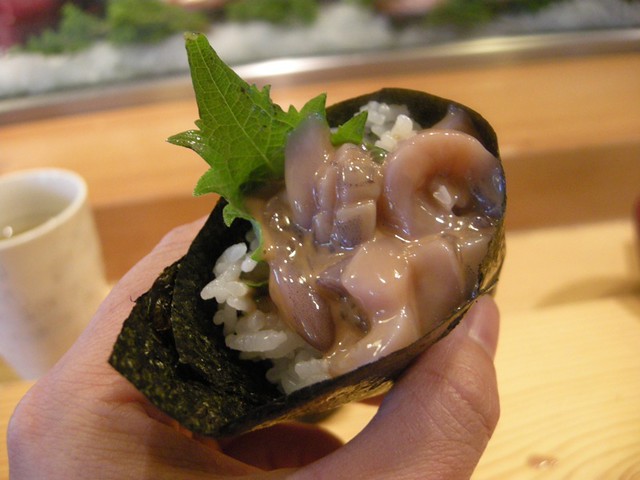
Ok, this is not an ordinary roll, but Kuni wanted me to taste his freshly-made
shiokara (marinated squid in guts) so he wrapped it up as a temaki with a shiso leaf. It is really delicious (and fabulously fishy), so you should ask for one if you are ever at Sushi Kuni.
Oshinko Maki
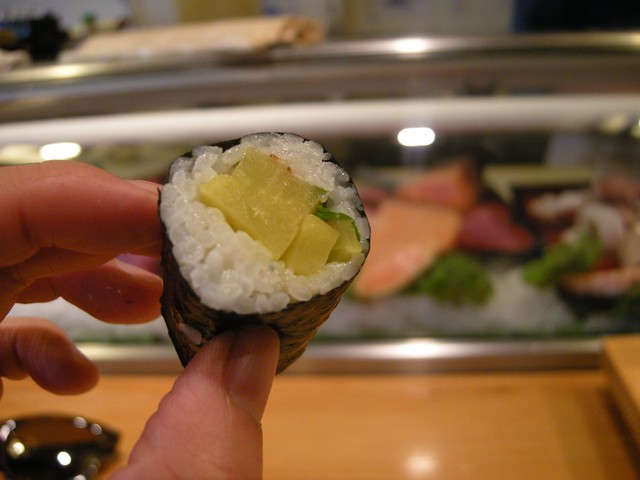 Oshinko
Oshinko are pickles. In
makimono, the pickles uses are usually the bright yellow
takuwan, which are pickled daikon radish. Here, Kuni adds shiso leaves for added flavor.
Umeshiso Maki
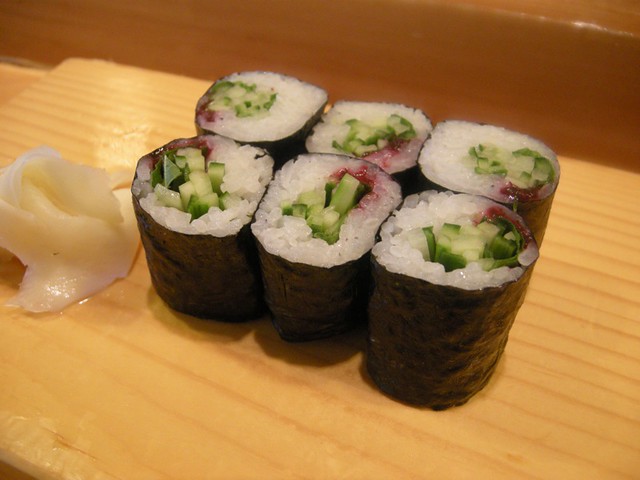
This is always my
shime (ending) of a sushi meal. The
ume (pickled plum) and shiso are a classic combination. I also ask for cucumber or sometimes
yamaimo (mountain potato).
I also often ask for
shari-nashi tamago at the end of a meal, which is the fried egg with no rice.
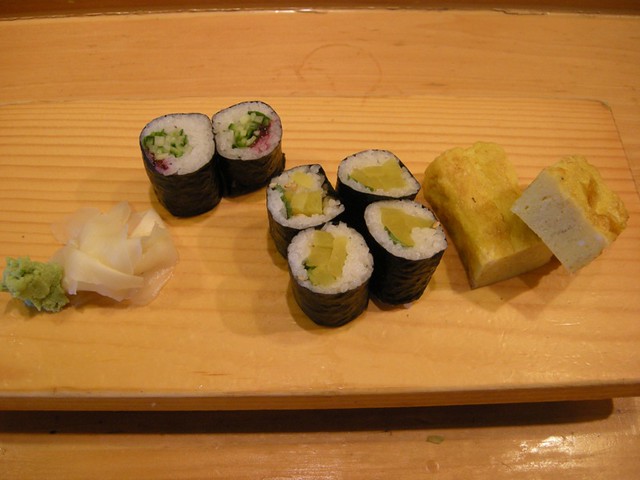 Makimono
Makimono are excellent interludes in a traditional sushi meal. Now, don't get me wrong -- I am a sucker for Spicy Tuna, California and Spider rolls too. And I always order a
negi-toro maki (toro with scallions). When I am too poor for fabulous nigiri sushi, I just go somewhere cheap for rolls. There's no shame in it, and the purists should just embrace the decadent sushi roll culture. Although Rainbow rolls really are kinda gross.
Thanks Kuni for the
makimono basics!
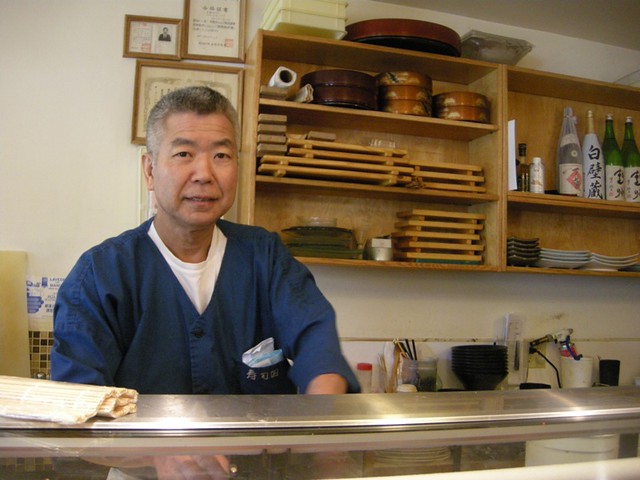
I will be continuing this column, hopefully monthly. If you have any sushi-related questions for Kuni, please feel free to comment below!
 Do you guys all know my pops? His name is Kunio, and he is a sushi chef. Classically trained as a tempura chef, he was offered to transfer to Los Angeles where Inagiku, the Tokyo restaurant he worked at, was opening a location in the iconic Bonaventure Hotel. So, the Akaboris all ended up in sunny LA in 1980.
Kuni has a sparkling sense of humor, but you wouldn't really think so if you saw him working at Sushi Kuni, his restaurant in Cupertino, CA. Handling raw fish is a sensitive matter, so he is all concentration, all the time.
Do you guys all know my pops? His name is Kunio, and he is a sushi chef. Classically trained as a tempura chef, he was offered to transfer to Los Angeles where Inagiku, the Tokyo restaurant he worked at, was opening a location in the iconic Bonaventure Hotel. So, the Akaboris all ended up in sunny LA in 1980.
Kuni has a sparkling sense of humor, but you wouldn't really think so if you saw him working at Sushi Kuni, his restaurant in Cupertino, CA. Handling raw fish is a sensitive matter, so he is all concentration, all the time.
 Kuni hates being photographed.
Kuni is a painter, and his artful mind comes out in his dishes. He loves to play with the colors of the ingredients, shapes and techniques. He is a great chef who is passionate about his work.
Today, let's talk about makimono, which literally translated to "wrapped things". In the world of sushi, we are talking about rice and condiments wrapped in crispy nori (seaweed). But in the overly-indulgent Western world of Spider, Rainbow and (Insert Local Sports Team Name) rolls, the real-deal makimono get no love. So let's get back to basics and highlight some of the makimono that you would actually be able to order at a sushi counter in Tsukiji market.
Hosomaki vs. Temaki
Kuni hates being photographed.
Kuni is a painter, and his artful mind comes out in his dishes. He loves to play with the colors of the ingredients, shapes and techniques. He is a great chef who is passionate about his work.
Today, let's talk about makimono, which literally translated to "wrapped things". In the world of sushi, we are talking about rice and condiments wrapped in crispy nori (seaweed). But in the overly-indulgent Western world of Spider, Rainbow and (Insert Local Sports Team Name) rolls, the real-deal makimono get no love. So let's get back to basics and highlight some of the makimono that you would actually be able to order at a sushi counter in Tsukiji market.
Hosomaki vs. Temaki
 Hosomaki is hoso = thin; maki = roll. It is usually cut into six pieces and are little bite-size portions.
Temaki is te = hand; maki = roll. Hence, the handroll. It is not cut up into pieces, and you just eat it... in hand. Temaki parties are also very easy and fun.
Tekka Maki
Hosomaki is hoso = thin; maki = roll. It is usually cut into six pieces and are little bite-size portions.
Temaki is te = hand; maki = roll. Hence, the handroll. It is not cut up into pieces, and you just eat it... in hand. Temaki parties are also very easy and fun.
Tekka Maki
 This roll is one of the most basic of the makimono. Fresh, raw tuna with rice and a dab of wasabi, wrapped in nori. Kuni tells me that this is roll was names after the tekka-ba, which was the name of the gambling halls back in the 1800s. According to Kuni, the invention of the tekka-maki came from when they served these little juicy finger food while the men were gambling. They are easy to eat, and so damn good. He believes that the tekka-maki was one of the very first makimono, preceded by the kanpyo maki (seasoned dried gourd), since they could be preserved for longer.
Kappa Maki
This roll is one of the most basic of the makimono. Fresh, raw tuna with rice and a dab of wasabi, wrapped in nori. Kuni tells me that this is roll was names after the tekka-ba, which was the name of the gambling halls back in the 1800s. According to Kuni, the invention of the tekka-maki came from when they served these little juicy finger food while the men were gambling. They are easy to eat, and so damn good. He believes that the tekka-maki was one of the very first makimono, preceded by the kanpyo maki (seasoned dried gourd), since they could be preserved for longer.
Kappa Maki
 Kappa maki is simply a fresh julienned cucumber roll. It is named after the mythical Japanese turtle-frog creature, kappa, who like to eat cucumbers.
Futomaki
Kappa maki is simply a fresh julienned cucumber roll. It is named after the mythical Japanese turtle-frog creature, kappa, who like to eat cucumbers.
Futomaki
 Futo-i means "fat" so this is literally a "fat roll". Different chefs have their own way of making them, but generally it will contain boiled spinach, kanpyo (seasoned dried gourd) and tamago-yaki (fried egg). Kuni also adds seasoned shiitake mushrooms and some ebi (shrimp).
Kanpyo on its own is a makimono classic, but I always end up getting Kuni's futomaki for all the additional ingredients.
Shiokara Temaki
Futo-i means "fat" so this is literally a "fat roll". Different chefs have their own way of making them, but generally it will contain boiled spinach, kanpyo (seasoned dried gourd) and tamago-yaki (fried egg). Kuni also adds seasoned shiitake mushrooms and some ebi (shrimp).
Kanpyo on its own is a makimono classic, but I always end up getting Kuni's futomaki for all the additional ingredients.
Shiokara Temaki
 Ok, this is not an ordinary roll, but Kuni wanted me to taste his freshly-made shiokara (marinated squid in guts) so he wrapped it up as a temaki with a shiso leaf. It is really delicious (and fabulously fishy), so you should ask for one if you are ever at Sushi Kuni.
Oshinko Maki
Ok, this is not an ordinary roll, but Kuni wanted me to taste his freshly-made shiokara (marinated squid in guts) so he wrapped it up as a temaki with a shiso leaf. It is really delicious (and fabulously fishy), so you should ask for one if you are ever at Sushi Kuni.
Oshinko Maki
 Oshinko are pickles. In makimono, the pickles uses are usually the bright yellow takuwan, which are pickled daikon radish. Here, Kuni adds shiso leaves for added flavor.
Umeshiso Maki
Oshinko are pickles. In makimono, the pickles uses are usually the bright yellow takuwan, which are pickled daikon radish. Here, Kuni adds shiso leaves for added flavor.
Umeshiso Maki
 This is always my shime (ending) of a sushi meal. The ume (pickled plum) and shiso are a classic combination. I also ask for cucumber or sometimes yamaimo (mountain potato).
I also often ask for shari-nashi tamago at the end of a meal, which is the fried egg with no rice.
This is always my shime (ending) of a sushi meal. The ume (pickled plum) and shiso are a classic combination. I also ask for cucumber or sometimes yamaimo (mountain potato).
I also often ask for shari-nashi tamago at the end of a meal, which is the fried egg with no rice.
 Makimono are excellent interludes in a traditional sushi meal. Now, don't get me wrong -- I am a sucker for Spicy Tuna, California and Spider rolls too. And I always order a negi-toro maki (toro with scallions). When I am too poor for fabulous nigiri sushi, I just go somewhere cheap for rolls. There's no shame in it, and the purists should just embrace the decadent sushi roll culture. Although Rainbow rolls really are kinda gross.
Thanks Kuni for the makimono basics!
Makimono are excellent interludes in a traditional sushi meal. Now, don't get me wrong -- I am a sucker for Spicy Tuna, California and Spider rolls too. And I always order a negi-toro maki (toro with scallions). When I am too poor for fabulous nigiri sushi, I just go somewhere cheap for rolls. There's no shame in it, and the purists should just embrace the decadent sushi roll culture. Although Rainbow rolls really are kinda gross.
Thanks Kuni for the makimono basics!
 I will be continuing this column, hopefully monthly. If you have any sushi-related questions for Kuni, please feel free to comment below!
I will be continuing this column, hopefully monthly. If you have any sushi-related questions for Kuni, please feel free to comment below!




Comments (5)
Awesome article Kayoko!
What, no natto maki?? Great post! I am a sucker for spicy scallop rolls.
In a future column, can he go give some insight into properly slicing sashimi (with/against/perpendicular to grain, etc.)? Thanks!
Sugoi!
I would totally love to see how a pro rolls up the maki to hold up well. My rolls always fall apart easily :-/
Oh, and book a table at the counter for July. I want to meet your peeps!!!
Wow I really need to go there when I am in Cupertino. Since I am here for the next two weeks I will make sure to GO!
Rad column idea. The man, the myth, the legend!